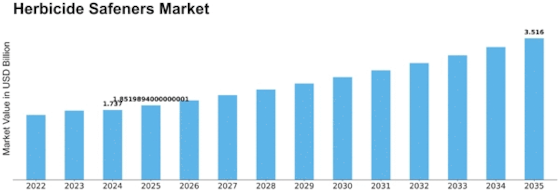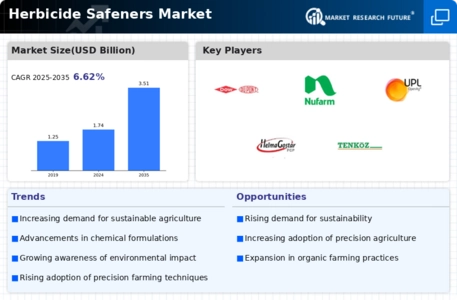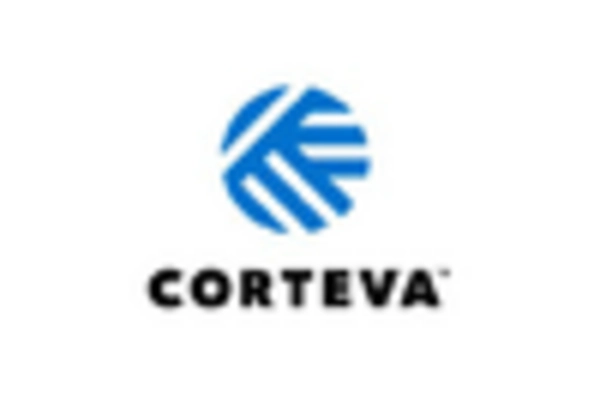Herbicide Safeners Size
Herbicide Safeners Market Growth Projections and Opportunities
herbicide safeners market size is influenced by various factors that shape its growth and dynamics. One significant factor is the increasing adoption of herbicides in modern agriculture to combat weed infestations and maximize crop yields. Herbicides play a crucial role in weed management by controlling unwanted plant species that compete with crops for nutrients, water, and sunlight. However, herbicides can also pose risks to crop safety and yield if applied incorrectly or under adverse environmental conditions. Herbicide safeners are chemical compounds added to herbicide formulations to protect crops from herbicide-induced injury while enhancing herbicidal efficacy, providing farmers with a valuable tool for weed control and crop protection.
Government policies and regulations play a crucial role in shaping the herbicide safeners market. Regulatory agencies impose standards and guidelines for the registration, use, and safety of herbicide and safener products to protect human health, environmental quality, and food safety. These regulations may include requirements for product testing, risk assessments, labeling, and application protocols. Moreover, government agencies may provide incentives, subsidies, or support programs to encourage the adoption of herbicide safeners and other crop protection technologies that promote sustainable agriculture practices and reduce pesticide risks.
Technological advancements drive innovation and growth in the herbicide safeners market. Research and development efforts focus on identifying novel safening agents, optimizing safener-herbicide interactions, and improving safener delivery systems to enhance crop safety and herbicidal performance. Advanced screening methods, computational modeling, and high-throughput assays enable the rapid discovery and development of safener candidates with improved efficacy, selectivity, and environmental compatibility. Moreover, advancements in molecular biology and genetic engineering facilitate the elucidation of safener mechanisms of action and the development of transgenic crops with inherent safening traits.
Market factors such as changes in agricultural practices and cropping systems influence the demand for herbicide safeners. As farmers adopt conservation tillage, reduced-input cropping systems, and herbicide-resistant crop varieties, there is a growing need for herbicide safeners to mitigate the risks of herbicide injury and crop yield loss. Herbicide-resistant crops, such as glyphosate-resistant soybeans and maize, allow farmers to use broad-spectrum herbicides for weed control, but they may also increase the risk of crop injury due to herbicide carryover or selectivity issues. Herbicide safeners offer a proactive solution to safeguard crops and optimize herbicide performance in diverse cropping systems.
Economic conditions and market competition impact the herbicide safeners market landscape. The affordability and availability of herbicide safener products are essential considerations for farmers, particularly in regions with diverse socio-economic backgrounds. Economic factors such as crop prices, input costs, government subsidies, and market demand influence farmers' decisions regarding safener adoption and herbicide use. Moreover, market competition among agrochemical companies, seed suppliers, and crop protection manufacturers drives innovation, product differentiation, and pricing strategies, benefiting farmers with a wide range of safener options and technologies.
Environmental considerations are integral to the herbicide safeners market, given its connection to agricultural sustainability and ecosystem health. Sustainable agriculture practices prioritize environmental stewardship, soil conservation, and biodiversity preservation, minimizing the ecological footprint of crop production. Herbicide safeners contribute to sustainable weed management by reducing the risks of herbicide-induced phytotoxicity, soil erosion, and off-target impacts on non-target plants and beneficial organisms. Moreover, safeners can enhance the selectivity and efficacy of herbicides, enabling farmers to use lower application rates and minimize pesticide residues in food and the environment.
Consumer perceptions and preferences also play a role in shaping the herbicide safeners market. Public attitudes towards pesticide use and crop protection technologies vary widely depending on factors such as cultural beliefs, scientific literacy, and media coverage. While some consumers express concerns about the potential risks of herbicides and safeners to human health and the environment, others recognize their importance in modern agriculture for ensuring food security, crop quality, and environmental sustainability. Consumer demand for sustainably produced food products and transparency in food production practices may influence farmer and industry decisions regarding pesticide use and safener adoption.
Herbicide Safeners Market is anticipated to achieve a size of approximately USD 2,435.2 Million by 2027, with a Compound Annual Growth Rate (CAGR) of 7.6% from 2020 to 2027. Herbicide safeners encompass a range of chemically diverse compounds known for their unique capability to safeguard crop plants from damage caused by specific herbicides, all while maintaining weed control effectiveness. Chemical safeners represent a practical, efficient, and straightforward approach to enhancing herbicide selectivity. This method has demonstrated successful application in various cereal crops including wheat, soybean, barley, maize, rice, and sorghum.


















Leave a Comment